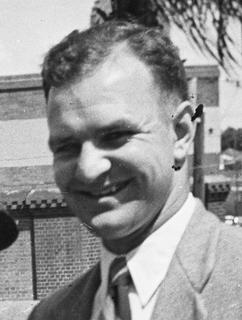 First Australian at the South Pole
First Australian at the South PoleWhile his former climbing partners grappled with the heat of a 1956 Queensland summer, Jon Stephenson (pictured) was about to start the journey of a lifetime. He had left for Antarctica from London in November that year, three days after finishing his PhD thesis on the geology of Mt Barney. In December 1957, he set out with colleague Ken Blaiklock to cross Antarctica with a dog team. They reached the South Pole on 19 January 1958.
On his return from Antarctica, Stephenson then led a 3-month expedition in 1960 to the Karakoram in Pakistan. After having collected a range of scientific data, Stephenson contemplated a possible attempt on K12 (7428m). He was awestruck by the surrounds as he explained in a letter to Bert Salmon: ‘This is quite fantastic country and surely the most thrilling in the world. Never have I dreamt of such magnificence on such a scale—it is astounding. Granite rock with spires and needles to rival Chamonix.’ The party set up Camp II and began searching for a route up the ridge, finding a crevasse barring their way—40 metres wide and 30 metres deep. Another Queensland climber on the expedition, Keith Miller, described the scene:
The chasm was spectacular. Never in my life have I seen such a place. Often it was necessary to climb between great slabs of ice as though pot-holing. The skyline silhouetted giant icicles 20 ft. long some 100 ft. above one’s head, just waiting to drop off. Twenty minutes down there was enough to find an escape route out up to the other side and many prayers were offered.
The wind raged for the next three days and they were tentbound. They deciding to retreat to base camp but first, Miller and Stephenson would ‘have a quick look at the ridge and try to reach the summit’. Miller continues:
What an abortive attempt we made. Within five minutes of leaving camp we were swallowed up in cloud. Then came a white-out in which it was impossible to discern the demarcation between ground and atmospheres. At this time we were advancing along a steep ridge when suddenly Stephenson walked over the edge and simultaneously I went through an ice hole. When we extracted ourselves we quickly descended to camp to be greeted by, “That was a quick excursion to the top!”
On the descent, Miller was struck by a block of falling ice and required hospitalization. Stephenson and a porter were the only ones fit enough to make one last summit attempt. But shortly before they were due to leave their high camp, the porter, too, fell ill. Stephenson decided to climb on alone:
The view was just extraordinary—and it kept getting better as you got higher. I couldn’t believe it. You just started to see further and further—you could see that horizon wasn’t flat, it was curved. And there was K2 and the other high peaks I could recognise…I got as far as I could and I sensed that I was going more and more slowly. You get to the point where I was counting my steps and I could only do 20 steps and then I’d have to rest. I could see how far I had to go and I judged that I’d be on the summit at five o’clock that night. In the end I took a round of photographs and had no difficulty in saying, “OK, it’s time to turn around.”
Jon Stephenson had reached 7000 metres—the highest point reached at that time by an Australian without supplementary oxygen. It was a record that would stand for many years. An American team on the summit of Masherbrum (7821m) that day for the first time could almost have waved at him. It was the 6 July 1960. Stephenson subsequently returned to Australia as Professor of Geology at James Cook University and spent years climbing and walking on Hinchinbrook Island in the 1980s and 1990s. He climbed Logan’s Ridge on Mt Barney in 2002, aged 71.
Picture: John Comino collection.
No comments:
Post a Comment